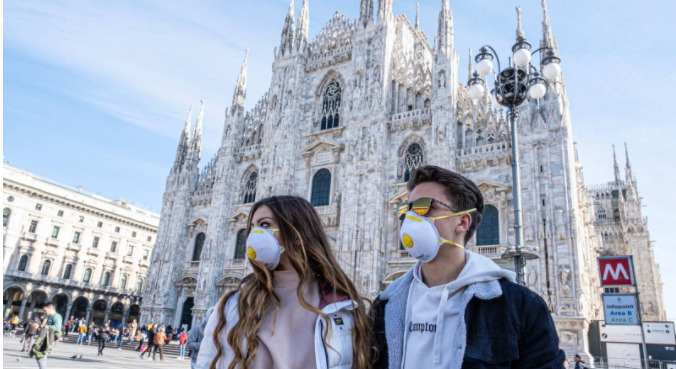In mid-March, the world experienced the first wave of COVID-19. All eyes were on Italy as it emerged as the newest coronavirus hotspot in the West. Pictures out of Milan showed overrun hospitals, people being turned away from emergency rooms and an empty piazza in front of the Duomo. And then, everything stopped.
On March 9, Italian Prime Minister Giuseppe Conte issued the first national lockdown order in light of the growing public health crisis, and Italians throughout the country stayed home.
The world watched curiously and wondered whether the national lockdown would work. Would Italians abide by the regulations? Or flaunt all the measures in place? Italians are known for living la bella vita, a slower lifestyle that informs much of its social culture. The Italian lifestyle was not meant to handle an interloper like coronavirus. The world, however, watched with great surprise when Italians obediently followed the national decree and stayed home.
At first, when the national lockdown was imposed, it looked as though the policy was failing. Cases rose and people who stayed in their homes infected members of their family. When the lockdown first started on May 9th, Italy only had 977 cases reported during that 24-hour period. Nine days after the lockdown was imposed, on March 21, Italy hit its peak caseload at 6,557 new cases in one day.
The multigenerational household, once a huge strength and point of pride for Italy, had seemingly become its downfall. The virus would infect one person and tear through the rest of the family, leaving the remaining members to grapple with the death and destruction of the virus. As Italy’s aging population was crushed by the virus, it became very clear that Italy’s older generations would not survive the pandemic unless major cultural changes were made. Of the 35,000 deaths that Italy has recorded so far, over 80% of them are from people over 70. Italians have recognized that with the highest median age in Europe, at 46.3 years, they are highly susceptible to another wave of death and economic destruction.
But, Italy can only function because of the critical role of the family. Most Italian families have several generations living under one roof — it’s part tradition and part necessity. Italy is not a very wealthy country, and when observing parts of the poorer South, it becomes a necessity to live as one unit. Other cultural factors, including declining fertility rates and welfare that’s more focused on pensions rather than youth unemployment benefits also contribute to this extended nuclear-family. Nonna and Nonno can watch the kids, help cook, and imbue religious traditions upon the next generation all while Mamma and Papà make the money for the family.
If one link in the chain is broken, the family risks falling into financial distress. Hence, the change in Italy’s pandemic response tactics to protect the immunocompromised and the elderly.
After Italy hit its peak caseload in late March, cases began rapidly falling. After three weeks of lockdown, new cases started to dramatically subside. While hospitals and frontline workers were catching their breaths, hope was on the horizon. The pandemic motto, Andrà tutto bene, meaning ‘everything will be fine,’ was plastered everywhere. By the time Prime Minister Conte lifted the nationwide lockdown on May 18th after two months, one week, and two days; the entire country only reported 415 new daily cases.
It was at that point that Italians reached a critical juncture: they could either undergo a cultural reset and forgo another wave of destruction, or return to their old ways and see the rest of the country collapse under the weight of the pandemic. Italians chose the former, making a purposeful lifestyle change to save their beloved culture and grandparents.
On May 18, Italy opened back up to confront the new normal of a COVID-19 world. Italians dutifully wore masks and stood 2 meters apart in public spaces — everywhere from grocery stores to espresso bars. And for the few that didn’t want to wear masks, heavy fines were implemented in an effort to coerce citizens into wearing masks in public. By and large, the Italians’ resilience and adaptability has been the reason they have so far avoided a second wave.
Additionally, Italy’s case study demonstrates why masks and other personal protective equipment are critical in preventing the spread of the coronavirus. As of June 28, 2020, 83.1% of Italians stated that they were committed to always wearing face coverings in public. This level of mask compliance is second only to Spain, where 84.1% of the population wears masks. The data coming from Italy speaks for itself; correct mask wearing and social distancing flattens the curve. From June 28, when that study was recorded, until the start of August, Italy never had more than 400 daily new cases.
With ample mask-wearing and correct social distancing, Italy has found itself in a favorable situation. At the same time, the economy is starting to rebound and Italians can safely go back to work, school, and vacation. The country also has a low prevalence of disease; which was purposefully created by citizens who complied with health regulations in order to save their families and their country.
The government’s swift and harsh lockdown, although delayed, saved the lives of thousands of citizens. The perseverance and empathy in protecting the older generations has made Italy’s pandemic response a unique case study and example for countries throughout the world that are continuing to tackle the crisis. And while Italy’s containment of the virus has been impressive so far, no country is out of the clear just yet.
Italy will face its biggest test of virus containment in the next few weeks in the aftermath of Ferragosto, a national holiday that unofficially signals the start of vacation season in Italy. Will we see a resurgence of cases and another lockdown? Only time will tell. And while la bella vita of Italy remains, it now exists in harmony with tri-colored green, white, and red masks and socially distanced espresso bars.







